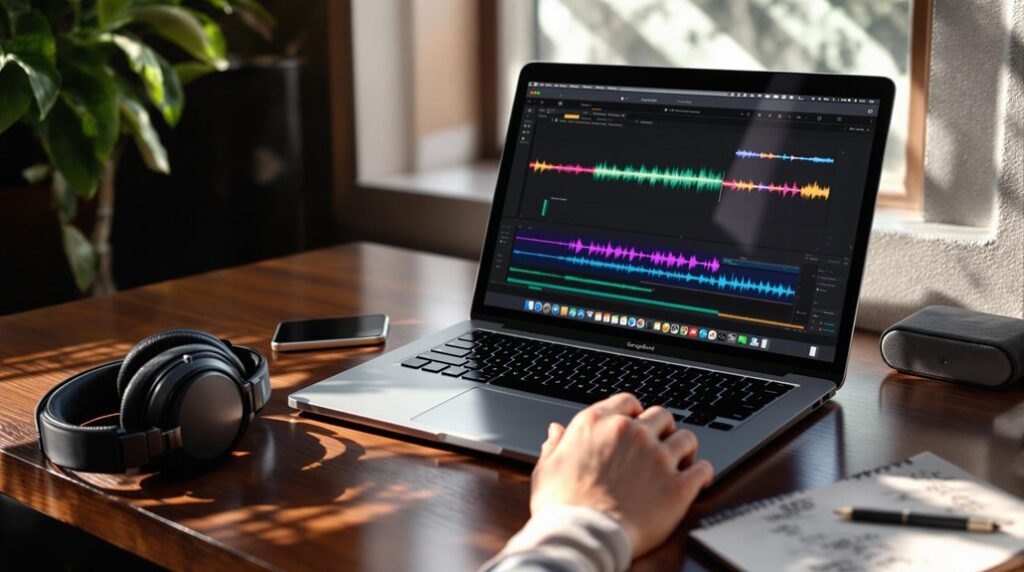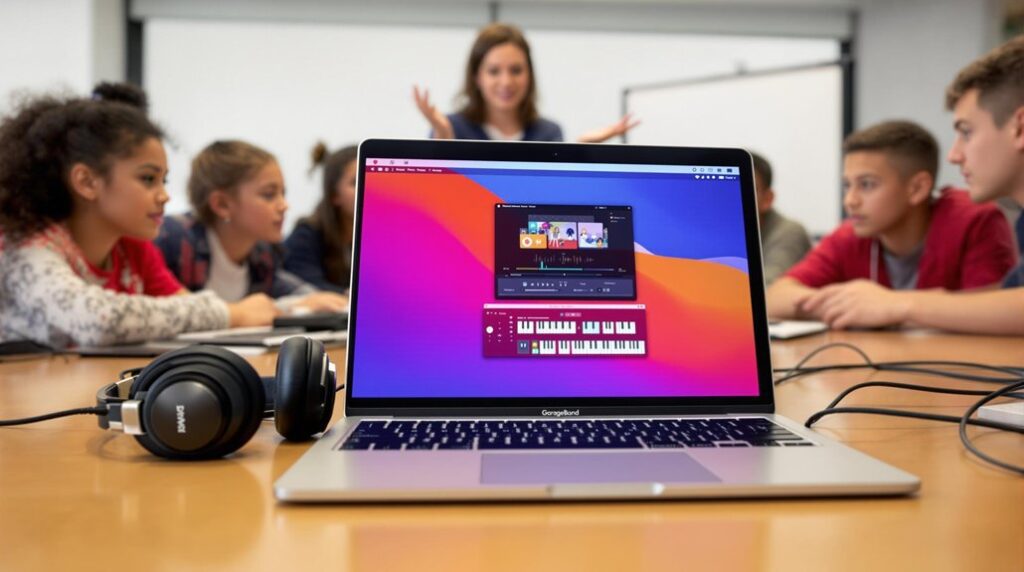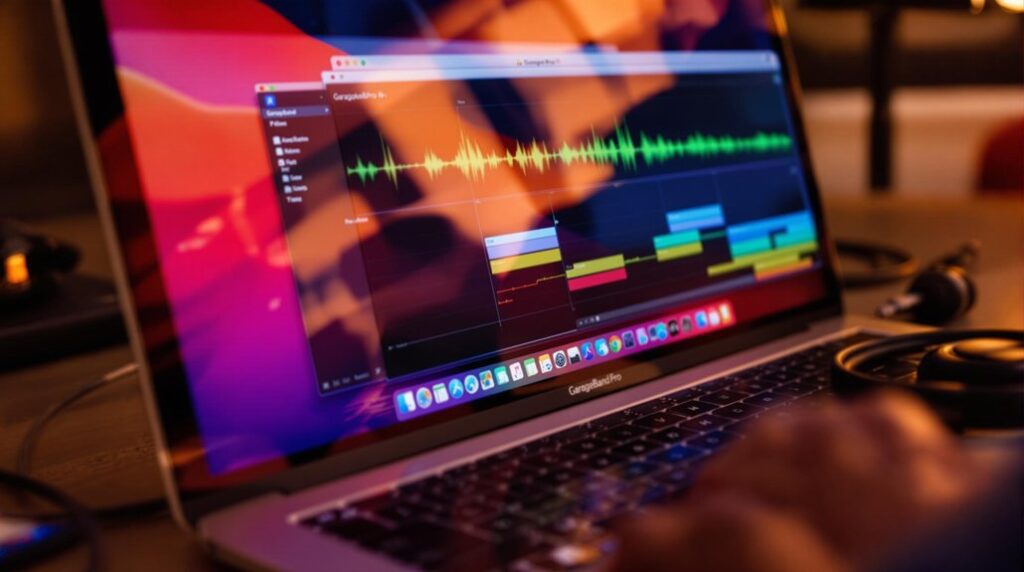Mastering music mixing in GarageBand requires a structured approach, starting with fundamental knowledge of audio balance through volume, panning, and effects. Initiate by preparing a static mix with optimal headroom using MVY Meter 2. Enhance tonal clarity through strategic EQ adjustments across key frequency zones, ensuring balance and separation. Precision in compression controls dynamics, with ideal ratios and attack times preserving clarity. Leverage automation for dynamic vocal and instrument adjustments, creating engaging spatial dimensions with reverb and delay. Compare your mix against professional tracks, focusing on stereo placement and headroom. Set forth on this journey to refine your craft further.
Key Takeaways
- Reset all volume faders to zero for an unbiased starting point.
- Use EQ to cut unwanted frequencies and enhance clarity in your mix.
- Apply compression to manage dynamics and maintain instrument and vocal presence.
- Automate levels for vocal and instrumental balance during different song sections.
- Reference professional tracks to assess and improve your mix quality.
Understand Mixing Basics
Mastering the fundamentals of mixing is essential for any music producer aiming to create a polished and cohesive sound.
At its core, mixing and mastering involve balancing individual audio tracks through precise manipulation of volume, panning, and effects. Establishing a well-balanced mix requires keen attention to detail; EQ is vital for sculpting the tonal environment by judiciously cutting or boosting frequencies, typically within the 4 to 6 dB range. Additionally, understanding compression is imperative for dynamic control, ensuring instruments and vocals maintain clarity and presence. Proper monitoring of peak levels using tools like MVY Meter 2 is essential, targeting -6 to -3 dB to preserve headroom and avert digital distortion. Implementing high-pass filters can eliminate unnecessary low-end frequencies and enhance mix clarity.
These elements form the foundation of a professional mix.
Prepare Your Static Mix
After grasping the foundational principles of mixing, it's time to initiate the static mix, a pivotal step in shaping your track's sonic architecture.
Start by strategically resetting all volume faders to zero and eliminating any mixing plugins, such as Reverb or Compression, to cultivate an unbiased auditory environment.
Utilize the MVY Meter 2 for precise peak level monitoring, aiming between -6 to -3 dB to guarantee ample headroom and prevent digital distortion.
- Volume and Panning: Adjust each track's volume and panning for ideal clarity and balance, free from effects interference.
- Regular Practice: Consistently hone static mix skills to enhance your aural dexterity and mix balance.
- Foundation: Set proper volume levels to establish a robust base for subsequent processing and enhancements.
GarageBand's user-friendly interface ensures accessibility for musicians of all skill levels, making it easier to focus on achieving a balanced static mix.
This approach fortifies the static mix's role as the bedrock of audio mastery.
Apply EQ Techniques
Harnessing the power of EQ techniques is essential in sculpting the tonal scenery of your track with precision. In GarageBand, mastering EQ begins by focusing on the six pivotal zones: sub, bass, low mids, mids, upper mids, and brightness. Cutting those unwanted frequencies, often more effective than boosting, allows for enhanced clarity and instrument separation. Aim to adjust within a 4 to 6 dB range for ideal balance. Implement a high-pass filter on one side to eliminate low-end rumble from non-bass instruments, ensuring a cleaner mix. Regularly juxtapose your EQ adjustments with professional tracks to maintain clarity and balance. Incorporating reverb and modulation effects in conjunction with EQ adjustments can further enhance the tonal quality and depth of the track. This meticulous approach to EQ will elegantly refine your mix, setting a robust foundation for the subsequent mixing processes.
Use Compression Wisely
Release the potential of your tracks by employing compression with finesse. To use compression wisely, it is vital to control audio dynamics, ensuring a polished mix. Begin by setting a compression ratio between 3:1 and 5:1, with the threshold targeting louder peaks. This approach maintains the integrity of your mix while enhancing its punch.
- Attack and Release: Set the attack time around 10-30ms to let transients pass, and adjust the release time (50-150ms) to match track tempo, preventing unnatural pumping effects.
- Vocal Compression: Aim for 3-6 dB of gain reduction to retain vocal presence without sacrificing natural sound quality.
- Regular Bypass Checks: Frequently bypass the compressor to compare processed and unprocessed audio, ensuring enhancement without detraction.
For those working with vocals, GarageBand includes a pitch correction tool that can be used alongside compression to achieve a balanced and harmonious sound.
Process the Master Track
Transforming your mix into a polished masterpiece begins with meticulously processing the master track. This critical phase involves fine-tuning the overall sound to guarantee cohesiveness among the individual tracks. Start by applying EQ to sculpt the low-end and high-end frequencies, achieving a balanced tonal spectrum that complements all elements. Next, employ compression to control dynamics, making sure instruments and vocals seamlessly integrate within the mix. Regular referencing against professionally produced songs can guide you in maintaining clarity and balance. Once a well-balanced static mix is established, subtle application of Reverb and Delay can introduce a spatial dimension, enhancing the auditory experience without introducing muddiness. Utilize reverb sends to maintain clarity and layering across multiple tracks for optimized workflow and sound quality. This careful processing of the master track raises your project to professional standards.
Implement Effects and Automation
Incorporating effects like Reverb and Delay into your GarageBand mix can greatly enhance spatial perception, but achieving a professional sound requires precise application—often maintaining effect levels between 10-20% to prevent sonic clutter. Dynamic volume adjustments through automation not only facilitate seamless shifts but also highlight pivotal elements without manual interference. Furthermore, refining shifts with automated effects parameters, such as reverb decay or delay feedback, can imbue your track with emotional depth and maintain listener engagement. Consistently referencing industry-standard mixes guarantees clarity and balance. To create nuanced sound shaping, experiment with delay types and settings, allowing you to achieve polished and sonically rich final products.
Reverb and Delay Tips
A crucial aspect of refining your mix in GarageBand is the nuanced application of reverb and delay, two effects that can dramatically enhance spatial and rhythmic dimensions when used judiciously.
Reverb is a powerful tool for creating depth; however, restraint is key. Typically, a mix level of 10-20% suffices to avoid muddiness.
Delay adds dimension and rhythm; a short delay time can produce a slapback effect, augmenting presence without overwhelming. Automation facilitates dynamic control, ensuring effects remain balanced throughout the track.
Consider these tips for ideal results:
- Experiment with Reverb Types: Choose between plate, hall, or room to complement your genre.
- Reference Tracks: Compare against industry standards to achieve a polished sound.
- Automation Precision: Adjust effect levels dynamically for clarity and engagement.
Dynamic Volume Adjustments
Harness the power of automation in GarageBand to sculpt dynamic volume adjustments that breathe life into your mix.
Start using the automation feature to program nuanced changes in volume levels over time, enhancing the emotional impact of your production. Access automation by selecting your desired track, steering to the mix menu, and utilizing the pencil tool to draw precise volume curves.
This technique guarantees smoother shifts and emphasizes key sections, such as amplifying vocals during choruses or attenuating instruments during verses.
Subtle use of effects like Reverb and Delay is essential; excessive application can muddy the mix.
Continuously adjust automation curves, listening in context to maintain balance, as inter-track interactions can appreciably alter perceived sound quality.
Enhancing Track Transitions
Seamlessly integrating effects and automation is essential for crafting smooth track changes in GarageBand. With everything you need at your disposal, utilizing effects like Reverb and Delay can sculpt a spatial dimension in your mix.
However, subtlety is key to prevent muddiness and preserve clarity. Automation provides dynamic control over volume and panning, facilitating fluid shifts and enriching the listening journey.
- Effect Parameters: Automate parameters, such as gradually increasing reverb during a chorus, to inject emotional depth and intrigue into shifts.
- Professional Reference: Continuously compare your work against industry-standard tracks to assess whether your shifts enhance or hinder your mix.
- Template Efficiency: Save automation curves and effect settings as templates, ensuring consistent quality in future projects while optimizing workflow efficiency.
With these techniques, your track shifts will resonate with professional polish.
Enhance With Professional References
While working to achieve a polished mix in GarageBand, referencing your work against professional tracks is essential for ensuring industry-standard balance and clarity. Focus on the left and right audio channels to achieve a balanced stereo field, ensuring each element is placed correctly within the mix. Utilize MVY Meter 2 for precise monitoring of peak levels, targeting -6 to -3 dB. This practice maintains headroom, avoiding digital distortion. Implement subtle EQ adjustments and compression on the master track to enhance sound quality, emulating techniques from professional studios. Leverage automation to dynamically control volume and panning, replicating the nuanced dynamics of industry-grade mixes. Experimenting with dynamic panning effects can enhance audio immersion by creating movement in the stereo field.
| Element | Technique | Goal |
|---|---|---|
| Stereo Field | Left & Right Bal. | Perfect Placement |
| Peak Levels | MVY Meter 2 | Headroom Maintenance |
| Master Track | EQ & Compression | Enhanced Sound Quality |
| Dynamics | Automation | Nuanced Audio Control |
Frequently Asked Questions
Does Garageband Have a Mastering Feature?
GarageBand lacks a dedicated mastering feature; however, mastering techniques can be applied using its mix processing tools. Users can utilize EQ, compression, and effects like Reverb and Delay on the master track for enhanced sound quality.
What Are the Steps to Mixing and Mastering?
To effectively mix and master, begin with foundational mixing techniques such as static mix, EQ adjustments, and compression. Enhance with reverb, delay, and automation. Conclude by comparing against professional tracks for ideal sonic balance and clarity.
Is Garageband Good for Mixing Music?
GarageBand is an effective platform for mixing music, utilizing intuitive design and robust Mixing Techniques such as EQ, compression, and automation. Its compatibility with plugins further enhances creative possibilities, making it suitable for both novices and seasoned professionals.
What Are the Master Effects in Garageband?
In GarageBand, mastering techniques include master effects like EQ for frequency balance, Compression for dynamic control, Limiting to prevent clipping, and Stereo Imaging for spatial enhancement, collectively elevating the track's audio quality and professional polish.
Conclusion
Mastering music mixing in GarageBand necessitates an extensive understanding of several intricate processes. By grasping mixing basics and preparing a static mix, the groundwork for a polished track is established. Effective application of EQ techniques and judicious use of compression further refine the sound. Processing the master track, implementing effects, and utilizing automation enhance the mix's dynamic qualities. Finally, referencing professional tracks provides critical insight, ensuring that the mix achieves industry-standard excellence.




